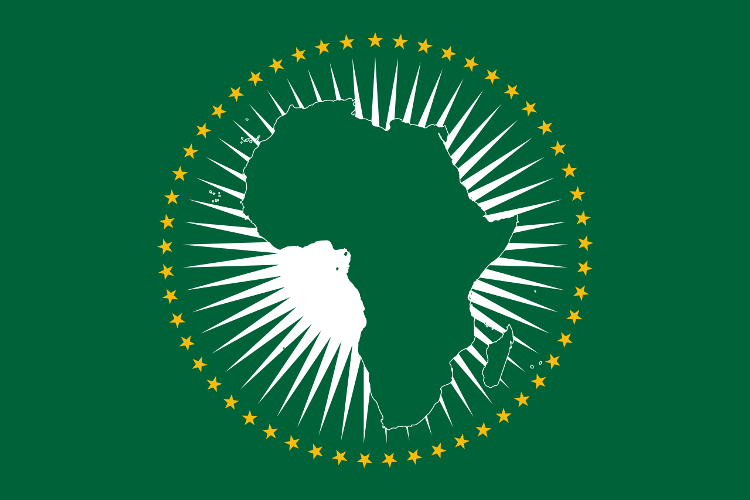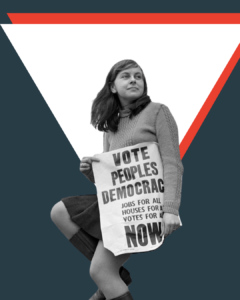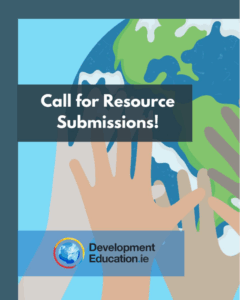Africa Day 2022 marked 59 years since the Organisation of African Unity (OAU) – now the African Union (AU) – was formed, and for many, was the first opportunity to truly celebrate African unity and diversity since 2019.
The COVID 19 pandemic has made all of us acutely aware of the need for connection and the need to be united in tackling global inequalities. The OAU’s formation was a key turning point in unifying the African continent and has made significant strides in supporting Africa to begin harnessing its full potential. Therefore, after celebrating Africa Day last week, it is helpful to go back in time over the last 140 years to realise how far African unity has come, the challenges the continent still faces, and the exciting future ahead.
Here, we present a brief timeline marking 36 moments and events with richly diverse stories of African struggle, unity and solidarity.
1884
Berlin Conference
The Berlin Conference formally regulates European colonisation of Africa and introduces the ‘principle of effective occupation’, which allows European powers to have rights (and claims) over African lands if they occupy and control them.
This led to a horrific period of increasing exploitation of African people’s rights and the large-scale export of its natural resources by European occupying powers. This resulted in forced labour, famine, mutilation and a lack of even basic healthcare for millions of African people.
This ‘effective occupation’ was driven by discriminatory European policies following the abolition of the Trans-Atlantic Slave Trade, such as segregating (or separating) white people from black people in economic opportunities, education and law making. Racial segregation came as a result of racist European policies which treated Africa merely as a source of profit, rather than a region home to approximately 131 million people at the time with many diverse cultures and histories.
1884-1914
Scramble for Africa
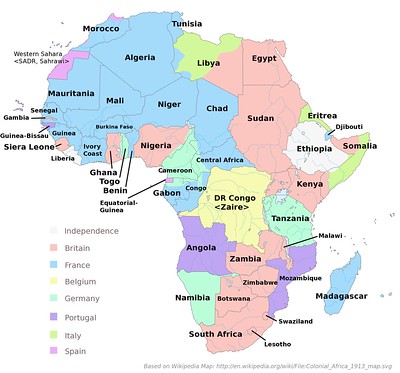
European powers’ ‘Scramble for Africa’ led to arbitrary borders being drawn without African input or consideration for ethnic, religious or linguistic histories. 90% of Africa is controlled by colonial powers, with only Liberia and Ethiopia remaining independent by 1910. South Africa and Egypt would become independent in 1910 and 1922 respectively.
1900
Origins of Pan-Africanism
Pan-Africanism is a movement focused on the unity and solidarity of all people of African descent and their diverse cultures and shared histories. It acknowledges that African cooperation and solidarity is essential in order for the continent to fulfil its potential.
While initially emerging as a response to, and a struggle against, the Atlantic slave trade and colonisation, its modern roots can be traced back to 1900, when Henry Sylvester Williams, a Trindadian lawyer of African descent, organised the First Pan-African Conference in London. Prior to independence, there were a further five Pan-African Congresses, all hosted in Europe. Ultimately, Pan-African ideals would go on to form the basis of decolonisation and the subsequent formation of the Organisation of African Unity (OAU).
1951-1980
Decolonisation
Following World War II, with European powers now crippled with war debt there was a renewed sense of African nationalism following a combination of European exploitation and African losses during the war.
As a result, 49 nations became independent in this period, with Ghana’s Kwame Nkrumah and the Gambia’s Alieu Ebrima Cham Joof being key figures in Pan-Africanism. Many nations struggled to adjust to independence as they had been marginalised and discriminated against for centuries.
1960-Present
Sharpeville and the Black Consciousness Movement

The Black Consciousness Movement (BCM) emerges as an anti-Apartheid, student-led movement in South Africa following the killing of 69 people and seriously wounding 180 in the Sharpeville Massacre where police fired on a crowd of 5,000-7,000 unarmed Black South African demonstrators who were protesting against a new ‘pass law’ that forced people to carry passbooks – a means of further controlling people’s movements. A political vacuum was further created by the jailing and banning of the African National Congress and Pan Africanist Congress leadership after the Sharpeville.
Looking inward to inspire confidence and build capacity to realise their own liberation and resistance, Black Consciousness was defined as ‘an attitude of mind’ or ‘way of life’ which encouraged black people to be proud of being black, while also fighting against oppressive Apartheid policies. Led by students Steve Biko, Mamphela Ramphele, and Barney Pityana, the BCM introduced community programmes to set up health centres and classes to improve literacy amongst black South Africans.
While initially non-violent, sections of the movement began using violence as a means of fighting back against Apartheid. BCM was hugely successful, organising large-scale protests throughout the 1970s and 1980s, with many black Africans feeling a renewed sense of pride. Apartheid ultimately ended in South Africa in 1994, yet the BCM lives on through community projects and continues to encourage people to be proud of their black identity.
1963
Founding of Organisation of African Unity (OAU)
On May 25th, 32 independent nations form the OAU in Addis Ababa, Ethiopia. They seek to promote African unity and co-operation, end colonialism in all its forms (including white-majority rule and apartheid) and support nations still seeking sovereignty. A Liberation Committee is set up in Tanzania to assist in achieving these goals. Other aims of the OAU include raising living standards on the continent, promoting human rights and solving disputes in a peaceful and diplomatic manner.
1963-1980
Enlargement of the OAU
The OAU continues to grow as more countries become independent and seek accession to the organisation. By 1980, there were 49 member states.
1976
Soweto Uprising

On June 16th, in Soweto township, Johannesburg, South Africa, thousands of students unite to protest against a government decision to make Afrikaans, a white minority language, the language of teaching in Soweto schools, a predominantly black area. South African police respond with brutal force, killing almost 700 people in the chain reaction of violence that followed over the year, many of which are children.
The police response causes huge domestic and international condemnation, which significantly increases pressure on the government to end apartheid. Now, June 16th is Youth Day in South Africa while across Africa, it is remembered as the Day of the African Child, which focuses on tackling issues African children face, while simultaneously celebrating their achievements.
1980
Lagos Plan of Action
The OAU passes the Lagos Plan of Action in Nigeria, outlining concepts of increased economic co-operation, which will go on to form the basis of the African Economic Community.
1984
Moroccan Withdrawal
Following the admission of the Sahrawi Arab Republic Front/Western Sahara, Morocco withdrew from the OAU in protest, as they also laid claim to the territory.
1986
African Commission on Human and Peoples Rights (ACHPR)
The OAU sets up the ACHPR to promote and protect human rights and also investigate alleged violations.
1991
The Abuja Treaty and the African Economic Community (AEC)
Member states of the OAU sign the Abuja Treaty, forming the AEC to focus on increased economic integration and creating a common African economic region, modelled off its European counterpart.
1993
Eritrea’s entry
After Eritrea formally splits from Ethiopia, they become the 53rd member of the African Union.
1994
South Africa joins
Following the end of apartheid and Nelson Mandela being elected to the Presidency, South Africa finally joins the OAU.
1999
Sirte Declaration
Libyan leader Muammar Gaddafi advocates for the creation of an African Union, with common political and economic goals. Furthermore, the AOU agrees to speed up the implementation of the Abuja Agreement by creating a Pan-African Parliament, an African Central Bank and an African Monetary Union. To date, only a Parliament has been formed.
2000
African Union beginnings
At Lomé in Togo, heads of state sign the Protocol, agreeing on the formation of the African Union.
2001
The African Union is born
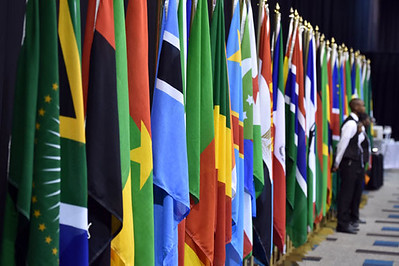
The AU officially comes into existence with 53 members, and co-exists alongside the AOU for a two-year transition period. Morocco refuses to join, in continued protest of Western Sahara’s recognition.
2001
AIDS Watch Africa
The AU forms AIDS Watch Africa to tackle the HIV/AIDS crisis on the continent, particularly in the southern and eastern regions. Sub-Saharan Africa accounts for approximately 69% of all HIV infections.
2002
The AU’s Inaugural Summit
Durban, South Africa hosts the newly formed organisation’s first summit with most African heads of state attending.
2003
Peace and Security Council
The AU’s Peace and Security Council is formed, with the power to send AU troops to conflict ridden areas of the continent, primarily for peacekeeping reasons, but also to intervene in ‘grave circumstances’, such as genocide or crimes against humanity. There are 15 member states, elected every two or three years, and all share equal voting rights. They have frequently worked with UN peacekeeping missions across the continent.
2004
Pan-African Parliament
In Midrand, South Africa, the AU’s Pan-African Parliament is inaugurated, with 265 elected representatives from all member states and the stated goals of promoting economic development and democratic norms. However, they have no decision-making power, and are merely an advisory body. The AU also send troops to Darfur, Sudan, along with UN peacekeeping forces.
2005
Somaliland’s Application
Somaliland, a democratic self-governing region in northern Somalia since 1991, formally applies for entry to the AU. This is rejected due to the AU recognising Somaliland as a part of Somalia, and being wary of opening ‘Pandora’s box’, with regard to other separatist movements on the continent. However, an AU fact-finding mission finds that Somaliland is a ‘unique case’, due to their previous, albeit brief, independence in 1960. There has been little movement on this issue since, with Somaliland still seeking formal AU and UN recognition.
2006
AU Mission to Somalia

AU troops are dispatched to Somalia, in an attempt to stem the violence which has been raging for decades, particularly in the southern area of the country, close to the capital Mogadishu. As of 2022, the AU mission remains, and Somalia continues to see large-scale conflict.
2009
Gaddafi’s ‘United States of Africa’
Libyan dictator Gaddafi is elected as Chairperson of the AU, and passionately encourages nations to form the ‘United States of Africa’. Countries such as Ghana, Senegal and Zimbabwe support his plans, while others such as South Africa, Kenya and Nigeria vehemently oppose them. Following Gaddafi’s death in 2011, the plan largely loses popularity, yet Zimbabwe’s dictator Robert Mugabe still shows some aspiration for a federation until his resignation in 2017.
2011
Arab Spring
In early 2011, grassroots protests spread across the Middle East and North Africa. They focus primarily on a lack of political freedom, corruption, poor living conditions and high unemployment. They begin in Tunisia, which ultimately leads to President Ben Ali being ousted.
Similarly, in Egypt, President Mubarak is ousted, while Gaddafi is toppled in Libya. Algerian protests result in the end of a 19 year state of emergency, while the King of Morocco is forced to make political concessions. Sudan also sees large-scale protests, but President Bashir would remain in power until he was deposed in 2019. Elsewhere in Africa, Djibouti and Mauritania also see protests.
2011
South Sudan’s entry
After formally splitting from Sudan, South Sudan becomes the African Union’s 54th member.
2012
A historic moment for African women

Nkosazana Dlamini-Zuma, South Africa’s interior minister, becomes the first woman to be elected as Head of the AU Commission, the highest rank in the organisation.
2012
Uganda’s Black Monday Movement
In October 2012, civil society in Uganda begin the Black Monday Movement (BMM), which centres around stopping corruption and theft and misuse of public funds by government officials. Every Monday since, grassroots activists have worn black to mourn the loss of these public funds, and spread awareness amongst Ugandans and the wider world.
2012-Present
Member states suspensions
Numerous states are suspended from the AU as a result of coups or election and political conflict. These include:
- Madagascar (2009-2014)
- Guinea-Bissau (2012-2014)
- Egypt (2013-2014)
- Central African Republic (2013-2016)
The four currently suspended countries are:
- Burkina Faso (2015 and again since January 2022)
- Guinea (2008-2011 and again since September 2021)
- Mali (2012-2013, again from August to September 2020 and yet again since June 2021)
- Sudan (June to September 2019 and again since October 2021).
2015
Agenda 2063
First proposed in 2013, Agenda 2063 is agreed and highlights initiatives the AU seek to carry out over the next 50 years. These include:
- a continent wide train network
- a free trade area
- an African Central Bank
- a Great African Museum
- an end to conflict, and
- an economic transition which focuses on manufacturing which actively uses resources the continent produces.
To date, levels of implementation are low, mostly due to lack of funding.
2016
African Union Passport
In Kigali, Rwanda, the AU agree on the introduction of an African Union passport, allowing visa free travel across all member states for African citizens. Rollout has been slow, but it is beginning to accelerate in recent years.
2017
Morocco rejoins the AU
After a 33 year absence due to Western Sahara’s recognition, Morocco agrees to rejoin the Union.
2018
African Continental Free Trade Area (AfCFTA)
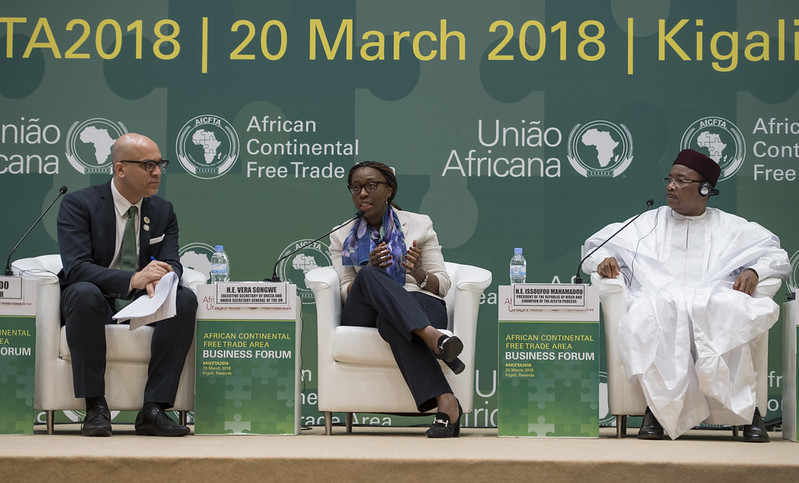
The AfCFTA is signed by 44 of the 55 AU members in Kigali, Rwanda in March, 2018. This number has since risen to 54, with only Eritrea refusing to join. This area plans to eliminate tariffs across the continent, boosting intra-African trade by 52% within the first few years. Crucially, this economic policy has been discussed, agreed, and implemented by Africans, for Africans.
This is in contrast to years of neo-colonialism and the idea of the ‘white saviour’, with many nations being used as proxies during the Cold War, notwithstanding disastrous IMF policies throughout the 1980s and 1990s. Furthermore, aid programmes from the West have generally failed to significantly improve development outcomes and standards of living.
2020-Present
COVID-19
As of May 2022, Africa has seen almost 12 million confirmed cases and over 250,000 deaths as a result. However, in reality these numbers are probably significantly higher due to a lack of adequate testing and medical facilities. Vaccination has been slow, with just 1% of the 1.3 billion vaccines injected globally being administered in Africa, as of June 2021. This is generally as a result of ‘vaccine nationalism’, where richer countries have bought a large amount of the supply.
The AU and the African Centres for Disease Control and Protection have been working to secure more vaccines and administer them as quickly as possible.
2021
AfCFTA launch
After numerous delays due to the pandemic, AfCFTA trade officially launches on January 1st. Having said this, it is largely symbolic, with the full implementation of tariff free trade expected to take many years. However, the potential for this agreement is huge, with the World Bank estimating that it could lift tens of millions of people out of poverty by 2035. Prior to implementation, there was an average tariff rate of 6% on the continent, which meant many nations exported the majority of their goods out of Africa.
2022
Protocol for free movement
In 2018, as a key aspect of Agenda 2063, a protocol for the free movement of people and rights of residence was adopted by the AU. Now, in May 2022, a draft continental strategy has been agreed on how best to accelerate this, which focuses on increased usage of the AU passport. So far, 33 nations have signed the protocol, and 4 nations have ratified it; Rwanda, Niger, Mali and São Tomé and Príncipe.
Kai Evans is a masters student in International Development at University College Dublin, and is an editorial intern with 80:20 Educating and Acting for a Better World.

